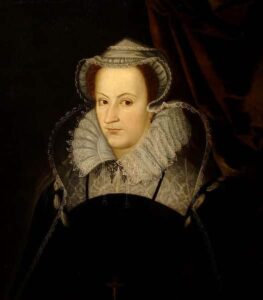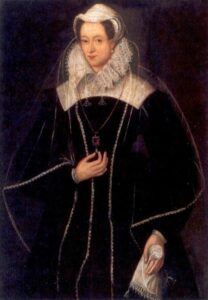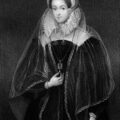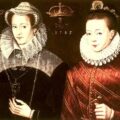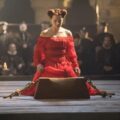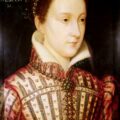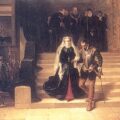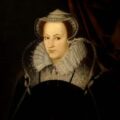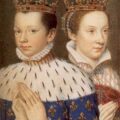On this day in history, the 8th February 1587, Elizabeth I’s arch enemy, cousin (once removed) and fellow queen, Mary Queen of Scots (Mary Stuart), was executed at Fotheringhay Castle. To commemorate her execution, I thought it would be good to look at her fall, trial, execution and just why she was executed by a fellow sovereign.
The Fall of Mary Queen of Scots
Although Mary Queen of Scots had been implicated in various plots against Elizabeth I, it was the Babington Plot which caused the downfall of this infamous queen.
The Babington Plot
In the chapter “The Tragical Execution” of “Elizabeth, the Queen”, Alison Weir writes of how, in March 1586, Philip of Spain wrote to the Pope requesting his blessing on an invasion of England and then, in May 1586, Mary Queen of Scots wrote to Mendoza to confirm her intention to “cede and give, by will, my right to the succession of the crown to your King your master, considering the obstinacy and perseverance of my son in heresy”. Mary was throwing her lot in with Spain and did not realise that all of her correspondence was being passed on to Elizabeth I’s spymaster, Sir Francis Walsingham. Walsingham was just waiting to catch Mary committing treason, and he did not have long to wait.
Just a few weeks later, Walsingham was handed two letters from Mary: one to Mendoza, confirming that she would support the Spanish invasion and that she would enlist James VI to help them, and another to Charles Paget, one of Mary’s supporters, asking him to relay to Philip of Spain the urgency of the invasion. Another letter which fell into Walsingham’s hands was Paget’s reply which named a Father John Ballard as the person chosen to incite a Catholic rebellion in England to coincide with the Spanish invasion.
Although Walsingham had all of these letters as evidence, he hung back and decided to put Ballard under surveillance and carry on intercepting Mary Stuart’s correspondence. His spies watched as Ballard visited Anthony Babington, a rich Catholic who was one of Mary’s supporters and who had already been involved in a plot to assassinate Elizabeth’s entire council in the previous autumn. In June 1586, Walsingham’s spies overheard Babington and Ballard plotting the murder of Elizabeth I but again Walsingham did not step in, he bided his time.
Mary Queen of Scots had already heard of Babington through her Paris agent, so it was not long before she was writing to him . In his reply of the 6th July 1586, Babington outlined how he and “six noble gentlemen, all my private friends” were planning to “despatch the usurper”, rescue Mary from her prison and place her on the throne of England, all with the help of Philip’s Spanish forces. On the 17th July, Mary’s two secretaries wrote a coded letter to Babington, copied from one written in Mary’s own hand. In this letter, Mary incriminated herself by saying:-
“The affair being thus prepared, and forces in readiness both within and without the realm, then shall it be time to set the six gentlemen to work; taking order upon the accomplishment of their design, I may be suddenly transported out of this place.”
With these words, Mary Stuart was giving her blessing to the plot and the murder of Elizabeth I. Walsingham had the evidence he needed to deal with Mary under the 1585 Act of Association and to finally get rid of this enemy.
On 4th August 1586, Ballard was arrested and imprisoned in the Tower of London. On hearing this news, Babington fled, ordering his associate, Savage, to murder the Queen on that very day. This could not be arranged in time and on that same day Elizabeth revealed the plot to her chief advisor, Wlliam Cecil, and paintings of the conspirators were quickly produced and distributed throughout England.
On the 9th of August, Mary’s belongings were searched and three caskets of letters seized and forwarded to Walsingham. Mary was then arrested. Babington was found on the 14th August hiding in St John’s Wood, north of London. He was taken to the Tower and his house was searched. Plenty of evidence was found in his house – prophecies of the Queen’s death along with “seditious” Catholic propaganda – and on the 18th August Babington confessed to his part in the plot and implicated Mary and his fellow conspirators.
Armed with Babington’s seven detailed statements concerning the plot, Elizabeth’s Council demanded that Elizabeth should summon Parliament and deal with Mary. Elizabeth was in a dilemma. She believed that Mary, like her, was a divinely appointed sovereign and Mary was also her relation, a woman who carried Tudor blood. However, things had got to the point where Elizabeth had to act. Mary had committed treason and had conspired to murder Elizabeth and seize the throne. On the 9th September Elizabeth summoned Parliament and on the 20th September Babington, Ballard and five other men were dragged on hurdles from Tower Hill, at the Tower of London, to St Giles’s Fields, Holborn, where they were hanged, cut down and “their privities cut off and bowels taken out alive and seeing”, beheaded and quartered – a full traitor’s death.
The Trial of Mary Queen of Scots
Alison Weir writes of how Elizabeth “had hoped that the deaths of the conspirators would satisfy her subjects’ thirst for blood and retribution” and wanted to spare Mary’s life, but her Council carried on pressurising her to proceed against Mary.
It may be hard to understand Elizabeth’s hesitation to deal with Mary but it was while watching David Dimbleby’s “The Seven Ages of Britain” last night that I finally understood her feelings properly. In last night’s episode, Dimbleby viewed the Wilton Diptych, a painting of Richard II, at the National Gallery. This painting depicts Richard II, flanked by St John the Baptist, St Edward the Confessor and St Edmund, kneeling before the Virgin Mary and the Christ child. Richard II has his hand open to receive from Christ a standard bearing the English flag which is also topped with a orb that contains an image of an island with a white castle on it, an island which is most certainly England. Why am I referring to a 14th century painting? Because it shows how Richard II believed that he was divinely appointed, that God had given him England, and this is just what Elizabeth believed. She believed that both she and Mary were divinely appointed sovereigns and so it was hard for her to come to terms with removing and killing a sovereign who had been chosen by God. Wasn’t she going against God’s wishes, God’s plan, by acting against Mary? A true dilemma and I can understand why Elizabeth kept stalling.
On the 25th September, Mary Queen of Scots was moved to Fotheringhay Castle in Northamptonshire and Elizabeth finally backed down and agreed to the appointing of 36 commissioners to act as judges in the case of Mary Queen of Scots. On the 11th October, the court, which included Walsingham, Paulet (Mary’s previous jailer), Hatton, Burghley (William Cecil) and two Catholic lords (Montague and Lumley) was convened. However, Mary refused to acknowledge the court, declaring that she, as a queen, was not subject to England’s laws:-
“I am no subject, and I would rather die a thousand deaths than acknowledge myself to be one!”
After Elizabeth wrote to her saying:-
“You have in various ways and manners attempted to take my life and bring my kingdom to destruction by bloodshed. It is my will that you answer the nobles and peers of the kingdom, as if I were myself present.”
and she was warned by Burghley that she would be tried in her absence, Mary agreed to stand before the court, although she still refused to acknowledge their jurisdiction. So, on the 14th October, the trial of Mary Stuart, Queen of the Scots, began.
Mary conducted her own defence, being denied counsel, and appeared before the court as a “big-made”woman whose faces was “full and fat, double-chinned and hazel-eyed”. She emphatically denied all knowledge of the Babington Plot, claiming that the letter from her to Babington was a forgery and that she had never corresponded with him. She went on to say that she “would never make shipwreck of my soul by compassing the death of my dearest sister.” Despite her impassioned defence, ther was just too much evidence against her and Burghley concluded that ther was no doubt that she was guilty. However, before the commission could pronounce her guilt, a messenger arrived from Elizabeth requesting that the court be adjourned to London and that it be reconvened in ten days’ time. An adjournment and delay did not change things, the commission pronounced Mary guilty of being an accessory to the Babington plot and of imagining and compassing the Queen’s death.
Continued in “Mary Queen of Scots – Part Two”
Sources
- “Elizabeth, the Queen” by Alison Weir
- “Elizabeth’s Women” by Tracy Borman
- “The Seven Ages of Britain” by David Dimbleby – Book and TV series.
